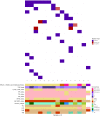Molecular profiling of male breast cancer by multigene panel testing: Implications for precision oncology
- PMID: 36686738
- PMCID: PMC9854133
- DOI: 10.3389/fonc.2022.1092201
Molecular profiling of male breast cancer by multigene panel testing: Implications for precision oncology
Abstract
Introduction: Compared with breast cancer (BC) in women, BC in men is a rare disease with genetic and molecular peculiarities. Therapeutic approaches for male BC (MBC) are currently extrapolated from the clinical management of female BC, although the disease does not exactly overlap in males and females. Data on specific molecular biomarkers in MBC are lacking, cutting out male patients from more appropriate therapeutic strategies. Growing evidence indicates that Next Generation Sequencing (NGS) multigene panel testing can be used for the detection of predictive molecular biomarkers, including Tumor Mutational Burden (TMB) and Microsatellite Instability (MSI).
Methods: In this study, NGS multigene gene panel sequencing, targeting 1.94 Mb of the genome at 523 cancer-relevant genes (TruSight Oncology 500, Illumina), was used to identify and characterize somatic variants, Copy Number Variations (CNVs), TMB and MSI, in 15 Formalin-Fixed Paraffin-Embedded (FFPE) male breast cancer samples.
Results and discussion: A total of 40 pathogenic variants were detected in 24 genes. All MBC cases harbored at least one pathogenic variant. PIK3CA was the most frequently mutated gene, with six (40.0%) MBCs harboring targetable PIK3CA alterations. CNVs analysis showed copy number gains in 22 genes. No copy number losses were found. Specifically, 13 (86.7%) MBCs showed gene copy number gains. MYC was the most frequently amplified gene with eight (53.3%) MBCs showing a median fold-changes value of 1.9 (range 1.8-3.8). A median TMB value of 4.3 (range 0.8-12.3) mut/Mb was observed, with two (13%) MBCs showing high-TMB. The median percentage of MSI was 2.4% (range 0-17.6%), with two (13%) MBCs showing high-MSI. Overall, these results indicate that NGS multigene panel sequencing can provide a comprehensive molecular tumor profiling in MBC. The identification of targetable molecular alterations in more than 70% of MBCs suggests that the NGS approach may allow for the selection of MBC patients eligible for precision/targeted therapy.
Keywords: clinically actionable genetic variants; copy number variations (CNVs); male breast cancer (MBC); microsatellite instability (MSI); precision oncology; targeted gene panel sequencing; tumor mutational burden (TMB); tumor profiling.
Copyright © 2023 Valentini, Silvestri, Bucalo, Conti, Karimi, Di Francesco, Pomati, Mezi, Cerbelli, Pignataro, Nicolussi, Coppa, D’Amati, Giannini and Ottini.
Conflict of interest statement
The authors declare that the research was conducted in the absence of any commercial or financial relationships that could be construed as a potential conflict of interest.
Figures




Similar articles
-
Tumour mutational burden, microsatellite instability, and actionable alterations in metastatic colorectal cancer: Next-generation sequencing results of TRIBE2 study.Eur J Cancer. 2021 Sep;155:73-84. doi: 10.1016/j.ejca.2021.06.037. Epub 2021 Aug 5. Eur J Cancer. 2021. PMID: 34365081
-
Identifying Genomic Alterations in Patients With Stage IV Breast Cancer Using MammaSeq: An International Collaborative Study.Clin Breast Cancer. 2021 Jun;21(3):210-217. doi: 10.1016/j.clbc.2020.08.009. Epub 2020 Aug 20. Clin Breast Cancer. 2021. PMID: 33191115 Free PMC article.
-
Diagnostic Validation of a Comprehensive Targeted Panel for Broad Mutational and Biomarker Analysis in Solid Tumors.Cancers (Basel). 2022 May 16;14(10):2457. doi: 10.3390/cancers14102457. Cancers (Basel). 2022. PMID: 35626061 Free PMC article.
-
ESMO recommendations on microsatellite instability testing for immunotherapy in cancer, and its relationship with PD-1/PD-L1 expression and tumour mutational burden: a systematic review-based approach.Ann Oncol. 2019 Aug 1;30(8):1232-1243. doi: 10.1093/annonc/mdz116. Ann Oncol. 2019. PMID: 31056702
-
Implementing tumor mutational burden (TMB) analysis in routine diagnostics-a primer for molecular pathologists and clinicians.Transl Lung Cancer Res. 2018 Dec;7(6):703-715. doi: 10.21037/tlcr.2018.08.14. Transl Lung Cancer Res. 2018. PMID: 30505715 Free PMC article. Review.
Cited by
-
HER2-Low Expression in Male Breast Cancer: Results from a Multicenter Series in Italy.Cancers (Basel). 2024 Jan 27;16(3):548. doi: 10.3390/cancers16030548. Cancers (Basel). 2024. PMID: 38339299 Free PMC article.
-
Assessing DNA Degradation through Differential Amplification Efficiency of Total Human and Human Male DNA in a Forensic qPCR Assay.Genes (Basel). 2024 May 14;15(5):622. doi: 10.3390/genes15050622. Genes (Basel). 2024. PMID: 38790251 Free PMC article.
-
Male Breast Cancer: Current Scenario and Future Perspectives.Technol Cancer Res Treat. 2024 Jan-Dec;23:15330338241261836. doi: 10.1177/15330338241261836. Technol Cancer Res Treat. 2024. PMID: 39043043 Free PMC article. Review.
-
Male Breast Cancer: a Review on Diagnosis, Treatment, and Survivorship.Curr Oncol Rep. 2024 Jan;26(1):34-45. doi: 10.1007/s11912-023-01489-z. Epub 2024 Jan 2. Curr Oncol Rep. 2024. PMID: 38224426 Review.
-
Performance assessment of computational tools to detect microsatellite instability.Brief Bioinform. 2024 Jul 25;25(5):bbae390. doi: 10.1093/bib/bbae390. Brief Bioinform. 2024. PMID: 39129364 Free PMC article.
References
LinkOut - more resources
Full Text Sources
Miscellaneous

